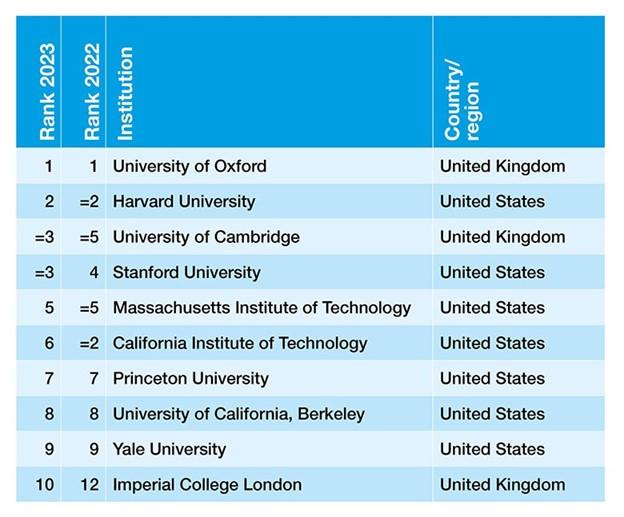A record of 1,799 universities from 104 countries and regions are featured in the latest edition of The Times Higher Education (THE) World University Rankings and U.S. standings are on the decline. This is the largest and most diverse university rankings up to date. The results, announced today, are based on 13 performance indicators which measure an institution’s performance across the areas of teaching, research, knowledge transfer, and international outlook.
More than 121 million citations across over 15.5 million research publications were analyzed for this year’s rankings and included survey responses from 40,000 scholars globally. Times Higher Education collected over 680,000 data points from over 2,500 institutions that submitted data.
U.S. universities in the top 100
There are 34 U.S. universities in the top 100, down from 38 last year and 41 five years ago. The University of Minnesota, the University of Maryland, College Park, Michigan State University, Ohio State University, and Dartmouth College dropped out of the top 100. In contrast, China has boosted its representation with seven universities in the top 100, up from six last year and three universities five years ago.
This reflects how the Chinese government has consistently invested in higher education, research and development for over 20 years. The Chinese funding is specifically targeted at developing world-class universities, training scholars at top institutions in the West, and building capacity in China, according to Times of Higher Education.
World University Rankings 2023: Top 10 universities
Founded in the 12th century and constituting the oldest English-speaking university, The United Kingdom’s University of Oxford remains at the top of the chart followed by Harvard University, and the University of Cambridge.

Image: Times of Higher Education
In the United States, the top universities continue to dominate. However, a split is emerging between the quality of the research output from elite universities and the rest of the pack, according to Times of Higher Education.
Trends in teaching and the learning environment
Measuring teaching and the learning environment includes analyzing data on teaching reputation, the staff-to-student ratio, doctorate-to-bachelor’s ratio, doctorates awarded to academic staff ratio, and institutional income with the latter showing the most variation between continents.
According to the results, the top scores for teaching are Hong Kong, Switzerland, and the United States. These scores correspond to countries with at least three universities ranked from 2019. Beyond that, Hungary shows the biggest improvement in teaching score over the past five years, followed by Saudi Arabia and Morocco.
Trends in research and citations
When it comes to university ranking metrics, research and citations are key. Research metrics measure research reputation, research income, and productivity while citations use Elsevier’s bibliometric data.
The top three regions with the highest scores in research include The Netherlands, Hong Kong, and Belgium. For citations, the highest score is for Hong Kong followed by Australia and Switzerland.
According to THE, an interesting trend shows that North America has comfortably led in research for several years. However, Oceania is surging ahead suggesting its strength is not being fully recognized in citations, as shown in the citation score by continent.
China is catching up when it comes to research quality, as citations show. Over the past year, China’s average score for citations has increased from 55.6 to 58.0; and in the same period, the U.S. score dropped slightly, from 70.0 to 69. “Overall, U.S. universities perform very well in the rankings, although their dominance is diminishing slightly over time,” said David Watkins, Head of Data Science at Times Higher Education.